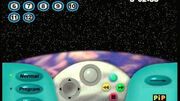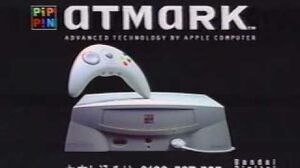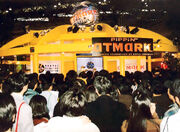The Pippin Atmark (ピピン アットマーク, PA-82001) is a Pippin console that was marketed by Bandai Digital Entertainment in Japan. Its parent company Bandai announced its partnership with Apple Computer on December 13, 1994 to produce the consoles and later provided an alternate version to Katz Media as an OEM.[1][2]
Hardware[]

Pippin Atmark music CD interface
Demonstration of the console's music playback functions.

Pippin Atmark Commercial
Broadcast on Japanese television in 1996.
Manufactured by Mitsubishi Electric,[3][4] the Atmark is nearly identical to Bandai's own Pippin @WORLD, which was released in the United States. It is also very similar to the Katz Media Player 2000, which was released in Europe and Canada, though the latter two models featured newer ROMs. The Atmark's revision 1.0 "KINKA" ROM could be updated through a 1.1 System Enabler or a 1.2 ROM Update extension that were included on authenticated CD-ROMs.[5] In December 1996, a ROM upgrade program was offered to Atmark owners as revision 1.2 ROMs were required in hardware to support external SCSI and MO 230 drives.[6][7] The ability to load a non-authenticated disc requires a revision 1.3 or developer ROM.[5]
Atmarks produced for the Japanese market typically came in platinum/white cases, while @WORLD and KMP2000 units that were built for other markets always came in black cases. A few black Atmarks were sold during the discontinuation of the platform and are considered very rare.[8][9]
Development history[]
Some consoles with "monitoring" ROMs were shipped to developers in the same retail case as the Pippin Atmark with nearly identical markings, except that the product ID of these "monitoring units" was PA-82001-S.[10]
Peripherals[]
Wireless versions of the AppleJack controller, modems, memory modules, and expansion docks were produced, but are rare.[5] Black variants are rarer.[8]
Marketing[]

Bandai's Pippin Atmark exhibit at Macworld Expo Tokyo '96.
Bandai Digital Entertainment unveiled the Pippin Atmark at a news conference in Tokyo on February 9, 1996.[11] Television ads were run as part of Bandai's marketing campaign in Japan.[12] Pre-ordering commenced on February 22, 1996 while Bandai showed off the console at Macworld Expo Tokyo.[11][13] A special "Network set" (「ネットワークセット」) with a 14.4 kbps modem and 6 bundled discs began shipping on March 22 and was launched through 300 retail outlets on March 28.[3][11] A lower-priced "Pippin Atmark body set" (「ピピン@アットマーク」「本体セット」) with 4 bundled discs became more widely available through retail channels on June 15, 1996.[14][15]
Bandai Digital Entertainment held a "Business Solution Seminar" on November 29, 1996 to promote the Pippin Atmark to businesses in Japan, which included case studies of its use in hotels and as a display kiosk.[16]
In 1997, J-DATA offered a rental package which included a Pippin Atmark console with 33.6 kbps modem, wireless controller and barcode reader for a monthly fee of JP¥ 6,800.[17]
Discontinuation[]

A rare black Pippin Atmark.
Manufacturing of new consoles was halted by Bandai on May 12, 1997 due to poor sales.[18] On February 27, 1998, Bandai announced that it would abandon the Pippin platform and close its subsidiary Bandai Digital Entertainment on March 13, 1998. Bandai had sold only 30,000 units in Japan and 12,000 units in the United States,[19] missing its original sales targets of 200,000 and 300,000 units, respectively.[20] Unsold U.S. inventory was returned to Japan to be repackaged for sale as the now-rare "Black Atmark".[9]
In March 1998, J-DATA was involved in the liquidation of Pippin titles and accessories in Japan.[21] Bandai ended support for the consoles on December 31, 2002.[22]
References[]
- ↑ Bandai Pippin FAQ, The Mac Geek. Accessed 2017-04-15.
- ↑ Bandai and Katz Media announce cooperation to develop European Pippin Market, Katz Media. Archived on 1997-07-13.
- ↑ 3.0 3.1 Apple's Pippin: A Pip--or a Pipsqueak? by Peter Burrows, BusinessWeek. 1996-04-01. Archived 2013-06-04.
- ↑ Mitsubishi to license Pippin games system, Telecom.paper. 1995-10-11.
- ↑ 5.0 5.1 5.2 Hacking the Pippin by Phil Beesley, Vintage Macintosh. 2007-10-22. Archived 2017-08-17.
- ↑ About ROM, Let’s play with PIPPIN (Japanese). Archived 2008-01-16.
- ↑ PEASE Turbo Support Page, Maki Enterprise. Accessed 2017-04-16.
- ↑ 8.0 8.1 Bandai Pippin Image Archive by Bryan G. Villados, The Mac Geek. 2017-04-15.
- ↑ 9.0 9.1 Video Game Bible 1985-2002, p.59 by Andy Slaven, Trafford Publishing. 2002.
- ↑ Pippin Atmark PA-82001-S Monitoring Unit by Rosewood, Retrostuff. 2019-09-15.
- ↑ 11.0 11.1 11.2 Pippin News: Bandai Takes Responsibility for Pippin Developer Support in the United States, The Apple Pippin Market Development Group. 1996-09-01. Archived 1997-04-14.
- ↑ Apple Bandai Pippin AtMark Commercial (WARNING:SEIZURES!) by OOYAMA, YouTube. 2016-10-25.
- ↑ Pippin Atmark 先行予約受け付け開始 (Japanese, EUC encoding) by 市原誠雄. 1996-02.
- ↑ Spec. (Japanese) by chemy cano, Pipp!n@Archive. Archived 2007-02-05.
- ↑ ピピン@アットマーク、店頭販売開始 (Japanese), PC Watch. 1996-05-28.
- ↑ PiPPiN Rental, J-DATA. Archived 1997-07-09.
- ↑ Bandai Stops Making Pippin Atmark Machines, Wall Street Journal. 1997-05-12.
- ↑ Bandai Says Goodbye to Pippin by Chris Johnston, GameSpot. 1998-02-27. Archived 1998-12-05.
- ↑ Power Ranger - A Japanese Toymaker Invades Cyberspace by Cesar Bacani and Murakami Mutsuko, CNN. 1996-04-19.
- ↑ That's Why Pippin (Japanese) by Koichi Hara, GeoCities. Accessed 2018-06-29.
- ↑ On the Apple PiPP!N by Stephen Hackett, 512 Pixels. 2012-11-18.
External links[]
- Bandai Pippin Museum & Archive at The Mac Geek
- Bandai Digital Entertainment's Japanese page (archived 1997-10-25)
- Pippin ATMARK Developer Support Center (archived 2001-06-20)
- PiPPiN@ATMARK (Japanese, Shift JIS) at MACお宝鑑定団. (accessed 2018-12-28)
- Apple Bandai Pippin at Wikipedia



